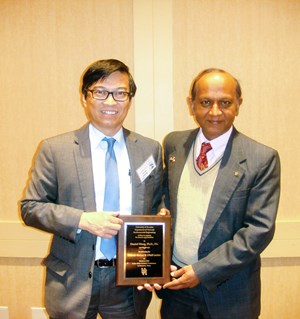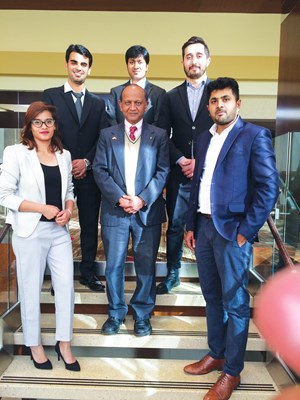May 2020 Vol. 75 No. 5
Rehab Technology
CIGMAT 2020
Convention Review
CIGMAT 2020 Focuses on Infrastructure, Energy, Geotechnical, Flooding, Sustainability
The University of Houston’s Center for Innovative Grouting Materials and Technology (CIGMAT) and the Department of Civil and Environmental Engineering held their 25th annual one-day conference on March 6 at the University Hilton Hotel on the campus of the University of Houston. The conference focused on the “Infrastructure, Energy, Geotechnical, Flooding and Sustainable Issues Related to Houston and Other Major Cities.” More than 280 attendees represented owners, consulting engineers, material supplies, contractors and academia.
Welcome remarks by Professor C. Vipulanandan, Ph.D., P.E., director of the Center for Innovative Grouting and Materials Technology (CIGMAT) and the Texas Hurricane Center for Innovative Technology (THC-IT), explained the need for highlighting the experiences in Houston and other major cities with rapidly growing population, new technologies and economic activities, as well as changing conditions and regulations.
General session
Moderated by Dr. Vipulanandan, the general session focused on expanding the highway transportation infrastructures, innovative solutions for public works and energy needs around the world over the next few decades.

Eliza Paul, district (Houston) engineer at the Texas Department of Transportation (TxDOT), discussed major completed, ongoing and new highway projects valued at over several billion dollars in the greater Houston area. These are intended to overcome traffic problems at locations that are ranked among the most highly congested, nationally.
In addition, TxDOT environmental issues, maintenance and funding were discussed by Michael Ereti, director of capital projects from the city of Houston Public Works department. This included updates on construction management programs, debris management and challenges after flooding from Hurricane Harvey, and new plans for continuing various operations with the growing population.
Cody Moffitt, marketing manager at Subsea Design AS, presented data about the history of outside influences on the oil and gas industry, and recent influences, such as the West Texas oil and gas production, on the highly fluctuating oil prices. Growth of industries and of the middle-class population around the world, especially in Asia, are increasing demand not only for oil and gas, but also for solar energy and wind energy production around the world.
Following the general session were four technical sessions with panel discussions on various topics highlighting the growth, challenges and changes happening in and around major cities.
Flooding and construction issues
Moderated by Rafael Ortega from Aurora Technical Services, Houston, the first technical session and panel discussion focused on “Flooding and Construction Issues” and related challenges.
Atul Hannan, director of the Planning Division of Harris County Flood Control, discussed using advanced technology for better modeling and risk mapping.
There are many hydrologic and hydraulic models, ranging from simple to complex, steady state, unsteady state and 2D models. Modelers have to select the appropriate software, based on the condition of the study site and the level of analysis, professional experience and cost, so they can understand the extent of flooding and map the floodplain or risk, accordingly.

Hannan presented two complex flooding problems modeled and mapped using 1D/2D model and compared with the effective maps. These advanced models give lot of extra information about depth, vector flow, and conveyance zone, for making better decision.
Kevin Tran, city of Houston; and Michael Salinas and Michael Liga from Lockwood Andrew and Newnam Inc., discussed options for constructing 5,000 linear feet (LF) of a 41,000 LF large diameter (120 to 54 inches) potable water pipeline via tunneling for the city of Houston.
These include open-face tunnel construction, which is typically performed when cohesive soils exist at the tunnel face and immediately surrounding the bore area, and groundwater can be controlled. A tunnel boring machine (TBM) with face closure abilities is recommended where non-cohesive soils are present or mitigation of settlement is critical, and groundwater can be adequately controlled.
A pressurized face TBM may be required where saturated, non-cohesive soils are encountered in the tunnel zone and dewatering is expected to be difficult or not possible. Subsurface chemical treatment to stabilize the insitu soil is also an option to create a suitable stratum for tunneling operations in conjunction with a non-pressurized face TBM. Each tunneling project is evaluated on a case by case basis to mitigate and minimize any settlement and instability concerns.
Shashi Kumar, public works director for Missouri City, reviewed city projects, plans and technical needs. As part of a regional water supply initiative and in partnership with 30-plus other Municipal Utility Districts (MUD’s) and private sector groups, the Missouri City is expanding capacity of its surface water treatment plant (SWTP) to meet projected growth and the Fort Bend Subsidence District groundwater conversion mandates.
Another project will regionalize and expand capacity at the Missouri City Steep Bank Flat Bank Wastewater Treatment Plant (SBFB WWTP), from three to 4.5 million gallons per day, due to rapid growth in master planned developments within the Sienna and Riverstone area.
Transportation projects & issues
The second technical session, on “Transportation Projects and Issues” and related challenges, was moderated by Stanley Yin from Tolunay-Wong Engineers, Houston.
John Tyler, deputy director of the Harris County Toll Road Authority (HCTRA) discussed ongoing projects and plans to improve mobility throughout the 130-centerline-mile system.
The 2020 Capital Improvement Projects (CIP) includes approximately $1.7 billion to continue widening parts of the Sam Houston Tollway and adding a new crossing, connecting Hardy Toll Road into downtown and constructing the Lorraine underpass, designing and constructing interchanges, developing a 100,000-plus-square-foot Customer Service facility to centralize operations, and relocating EZ TAG stores.
Bridgette Towns, executive vice president of Project Management and Engineering at Houston’s METRO, talked about maintenance and expansion projects for the coming years, including growth of the light rail system, especially around the medical center, and development of new neighborhood transportation facilities.
Water, wastewater issues
A third technical session and panel discussion, on “Water and Wastewater Issues,” was moderated by Mackrena Ramos, P.E., senior associate at Lockwood, Andrews and Newnam, Houston.
Cristina Brantley, manager-Engineering of San Antonio Water System (SAWS), addressed the history of SAWS’ Wastewater Collection and Treatment systems and key considerations, major phases, lessons learned and program effectiveness of the Sanitary Sewer Overflow (SSO) Consent Decree (CD) process.
As one of more than 40 U.S. cities with SSO issues as part of a CD, San Antonio has 12,500 miles of pipelines,100,000 manholes, 73 water pump stations, 191 wells, 117 storage tanks, 153 lift stations and four treatment plants. Since 2010, SAWS has reduced SSOs by over 60 percent and has CIPs totaling more than $2.3 billion for the next five years.
Erika Mancha, manager of Innovative Water Technology at Texas Water Development Board (TWDB), reviewed current programs and increasing interest in recycling of water and storing of flood water in the aquifers.
Eric J. Dupre, technical director at SuperCover, discussed Houston’s Sewer Overflow issues, emphasizing the need to look at alternative technologies to keep and contain all sewer inside the system until it reaches the wastewater treatment plant so that it may be properly treated for discharge.
Engineering ethics & smart materials
Daniel Wong, CEO of Tolunay-Wong Engineers, Inc. delivered the 15th annual Mike O’Neill Lecture: “Civil Engineering, Ethics and Public Policy.” Ethics becomes paramount as the health, safety and welfare of the public depend on the civil engineer’s performance.
With licensing and enforcement by the State Board of Professional Engineers and public surveys consistently reporting a highly ethical image of civil engineers, it may make sense for them to participate in the public policy discussion. However, this is difficult because of the conflict between the high-accuracy nature of civil engineer and the non-exact nature of the public policy arena.
Better engineering judgment that is needed not only in technical matters, but also in public policy, can be achieved by more training of civil engineers in finance, psychology and management; skills in negotiation and debate; and emotional intelligence.
Wong was followed by Vipulanandan’s presentation on “Smart Cement Characterization Based on Laboratory and Field Test Data Using Artificial Intelligent (AI) Models with Vipulanandan Models for Application in Cemented Wells and Micropiles.”
In this study, laboratory and field test data were used to verify the Artificial Intelligent (AI) models with Vipulanandan models for smart cement applications. The performance of the smart material in the cemented wells will be very much influenced by the hydration of the cement, which is affected by the environment and ground geological conditions.
Hence, laboratory tests were performed to collect the data for AI model training and verification. This also set the baseline for comparing AI with the cement hydration in the field test model simulating the cemented wells and micropiles.
Electrical resistivity, a material property, has been selected to monitor the smart cement from the time of mixing through its entire service life. The resistivity changed by over 12.85 times (1,285 percent) in 28 days under the room-curing condition, indicating the sensitivity of resistivity for monitoring. Smart cement is piezoresistive cement and the piezoresistivity strain at compressive stress failure for the smart cement was over 250 percent – more than 1,250 times higher than the compressive failure strain of 0.2 percent.
The field well was installed using standard casing of 9 5/8 inches (245 mm) in diameter and was cemented using the smart cement with enhanced piezoresistive properties. The field well was designed, built and used to demonstrate the concept of real-time monitoring of the flow of smart cement and hardening of the cement in place. It was installed in soft swelling clay soils to investigate the sensitivity of the smart oil well cement.
Change in the resistance of hardening cement was continuously monitored, since the installation of the field well spanned over 4.5 years (1,600 days) and over 10,000 data have been collected. Also, the temperature and strain changes in the cement were measured at various depths.
The field well cement performances were very much influenced by the weather changes and the depth in the ground, and the resistivity change varied by 270 percent to 950 percent. In addition, the pressure testing showed the piezoresistive response of the hardened smart cement. A piezoresistive model has been developed to predict the pressure in the casing from the change in resistivity in the smart cement.
Both laboratory and field data, including weather data, were used in the analyses. With a total of over 1,500 data in this study, 80 percent was used for training the AI model and 20 percent was used to verify the AI model predictions with the Vipulanandan model prediction.
The AI models predicted the long-term laboratory smart cement curing and piezoresisitive behavior, and field data of resistivity changes, with depth and time, very well, and were comparable to the Vipulanandan p-q curing and piezoresistivity models.
Special events/wrap-up
During the lunch break, Waller County Judge Trey Duhon talked about infrastructure issues, including construction and maintenance of new and old facilities in a county with agricultural activities and also neighbors Harris County.
A reception followed the technical sessions in the exhibit area. In addition to conference attendees, city, county and industrial leaders viewed posters on research activities at CIGMAT and within the department of civil and environmental engineering. A number of grouting, pipe manufacturers, material suppliers, pipe condition monitoring and wastewater rehabilitation companies participated in the exhibition.
The CIGMAT 2020 Proceedings are posted on the CIGMAT web site http://cigmat.cive.uh.edu. The next conference, CIGMAT-2021, will be held on March 5, 2021 at the University Hilton, University of Houston. •




Comments